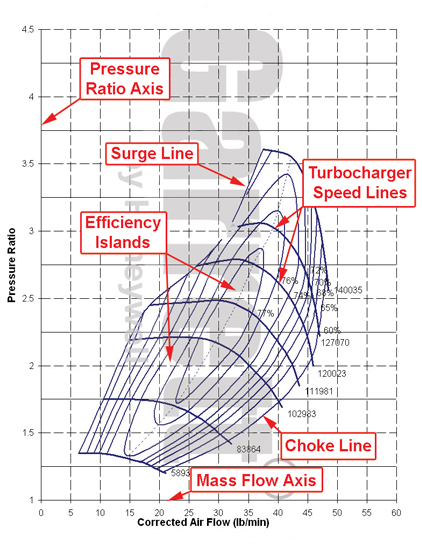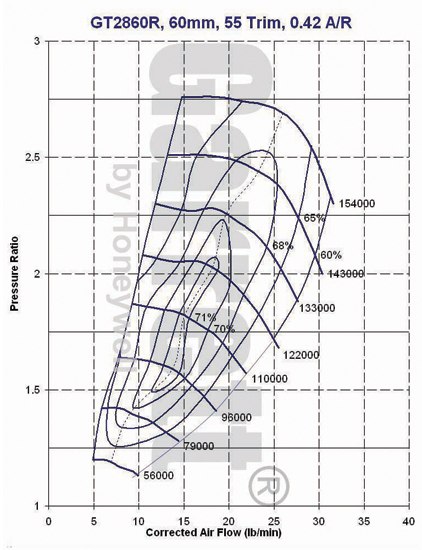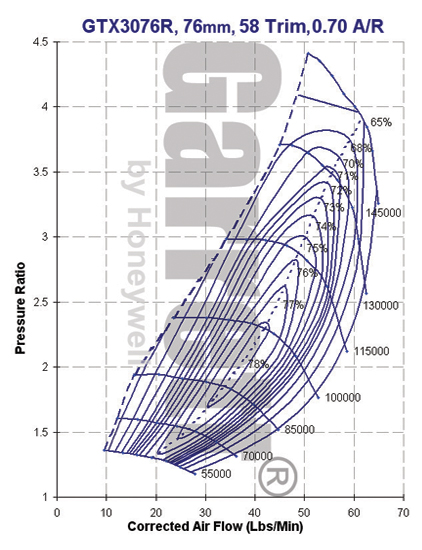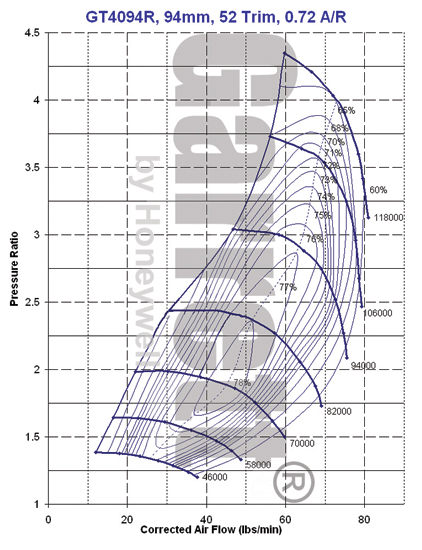All About Turbochargers – Part 7: Turbo Compressor Maps

It’s a part of that voodoo of turbocharging and you can get lost despite having a turbo compressor map. Don’t worry; we’ll help guide you down the path of Turbo Treasure.

It can be very, very confusing for those just getting into turbocharging. While many turbo and engine combinations have been tried on many engines before, not every turbo has been tried on every Jeep engine. How do you know if you have the right turbo for your application? Well, learning to read a turbo compressor map is how. Here are the things you need to know thanks to Garrett Turbo.
On the left-hand side of most map grids are the Pressure Ratio lines. This is calculated by taking absolute outlet pressure (what your turbo is putting out) and dividing it against absolute inlet pressure (absolute atmospheric pressure). Remember how we talked about absolute atmosphere versus what your gauge will read? Well, absolute outlet pressure is what your atmospheric pressure is plus what your boost gauge is reading. So, if you’re boosting to 10 PSI and your atmospheric pressure is 14.7 PSIA (PSI absolute) then your absolute outlet pressure is 24.7 PSIA. Keep in mind this is not accounting for pressure losses, restrictions, or gauge inaccuracies.
Now, to get your pressure ratio, you divide your absolute outlet pressure against absolute inlet pressure. In our example you’re looking at 24.7 PSIA/14.7 PSIA = 1.68 PR (Pressure Ratio). Again, this is our example for normal sea level, you’ll have to find your absolute atmospheric pressure and your true gauge pressures for your own estimation.
At the bottom of the map is the mass flow rate, which is the mass of air flowing through the whole system (both engine and compressor) over a given time expressed in pounds per minute (lb/min).
You could measure the actual flow rate, but estimation is good enough to get you started when you look for a turbo. The easiest way to figure this out is to set a target peak horsepower while following a general rule of 9.5 to 10.5 horsepower per lb/min. So, if you’re looking at 400 horsepower, you’re looking at around 36 to 44 lb/min.
Now we look at the part of the map that looks like an elevation map. The far left-hand side of it is the surge line. Surge is instability and is characterized by fluctuating boost and sounds like a barking dog when a turbo does it. We talked about boost surge in blow-off valves, but your turbo can surge when it is simply too big. Yes, size matters in turbos and bigger isn’t always better! Surging will stop with the use of blow-off valves, or when the turbo speed is slowed enough to catch back up.
The far right-hand side of the map is the choke line, and it is defined by Garrett as the point in which turbo efficiency drops below 58%. This is important because at this point you’ll start to over-speed the turbo.
The lines going across the map are the turbo speed lines. These lines represent the speed in which the turbine and compressor wheels are driven. Yes, your turbo could see over 90,000 rpm regularly and top out at over 140,000 rpm. That’s nearly fast enough to create a portal to a new dimension.
While I compared it to a topographical map, you really should see each elliptical line as islands, hence the name efficiency islands. The center of the map is the highest efficiency of your particular turbo, and efficiency drops the farther off-center you are.
Now that you know what each part of a compressor map is for, let’s figure out how to land on the right island. You’ll need to figure out a few things before we go further. Here’s what you’ll need to know:
- Your horsepower target
- Engine displacement
- Your engine’s max RPM (redline)
- Ambient conditions for both temperature and barometric pressure (atmospheric pressure)
You’ll also need to estimate the following:
- Engine Volumetric Efficiency — most modern four-valve engines are 95 – 99 percent. Your two-valve Jeep engine will be 88 – 95 percent.
- Intake Manifold Temperature — estimate this to be 100 – 130 degrees Fahrenheit with an intercooler, 180 – 300 degrees without.
- Brake Specific Fuel Consumption — turbo engines have a BSFC of .50 to .60.
Now, let’s get our example up again. We’re targeting 400 horsepower for our 2.7-liter four-cylinder. We’ll say it’s a two-valve engine. We’ll need to get airflow first, which will be Wa in our equation.
To figure out Wa, you’ll solve: Wa=Target HP*Air/Fuel Ratio*(BSFC/60). Most turbo cars will have an average air/fuel ratio of 12.0., so our example engine will be 400*12*(.55/60) = 400*12*(.00917) = 44 lb/min.
Next, we need to know how much manifold pressure our example will need to make 400 horsepower. That requires another equation along with our 44 lb/min. To get MAPreq (the pressure we need), we have to now solve the following: MAPreq=(Wa*R*(460+Tm))/(VE*(N/2)*Vd). So, what did that mess of letters mean?
- Wa (Airflow actual)
- R (Gas constant, which is 639.6)
- Tm (Intake Manifold Temperature in Fahrenheit)
- VE (Volumetric Efficiency)
- N (Engine RPM)
- Vd (Engine Displacement in Cubic Inches, if you have it in liters, like our example, multiply by 61.02)
Now, for our example:
(44*639.6*(460+130))/(.88*(6500/2)*(2.7*61.02) = (44*639.6*(590))/(.88*(3250)*(165)) = 16604016/471900 = 35.19 PSIA
Now, since that is PSIA, subtract our ambient atmospheric pressure of 14.7 PSIA to get 20.49 PSIG. Finally, we’ll need to get our pressure ratio, which is 35.19/14.7 = 2.40 PR. We have our intersect points for the turbo map of 44 and 2.40. Who said you wouldn’t use algebra again? Now, let’s see what Garrett Turbo we will use.
 If we start with the Garrett GT2860R, we’ll see that it is too small for our engine as it is well past the choke line. Let’s try a bigger turbo.
If we start with the Garrett GT2860R, we’ll see that it is too small for our engine as it is well past the choke line. Let’s try a bigger turbo.
 Next up is the Garrett GTX3076R and it’s nearly perfect! We are well within an acceptable island, but can we do better?
Next up is the Garrett GTX3076R and it’s nearly perfect! We are well within an acceptable island, but can we do better?
 Things look very promising with the Garrett GT4094R. We are just about in that center island. Now remember, this was our own example. You’ll need to figure out your own, but this should help you get there.
Things look very promising with the Garrett GT4094R. We are just about in that center island. Now remember, this was our own example. You’ll need to figure out your own, but this should help you get there.
Click over to the next page for the final chapter where we demonstrate how E85 and nitrous can benefit turbocharging.
